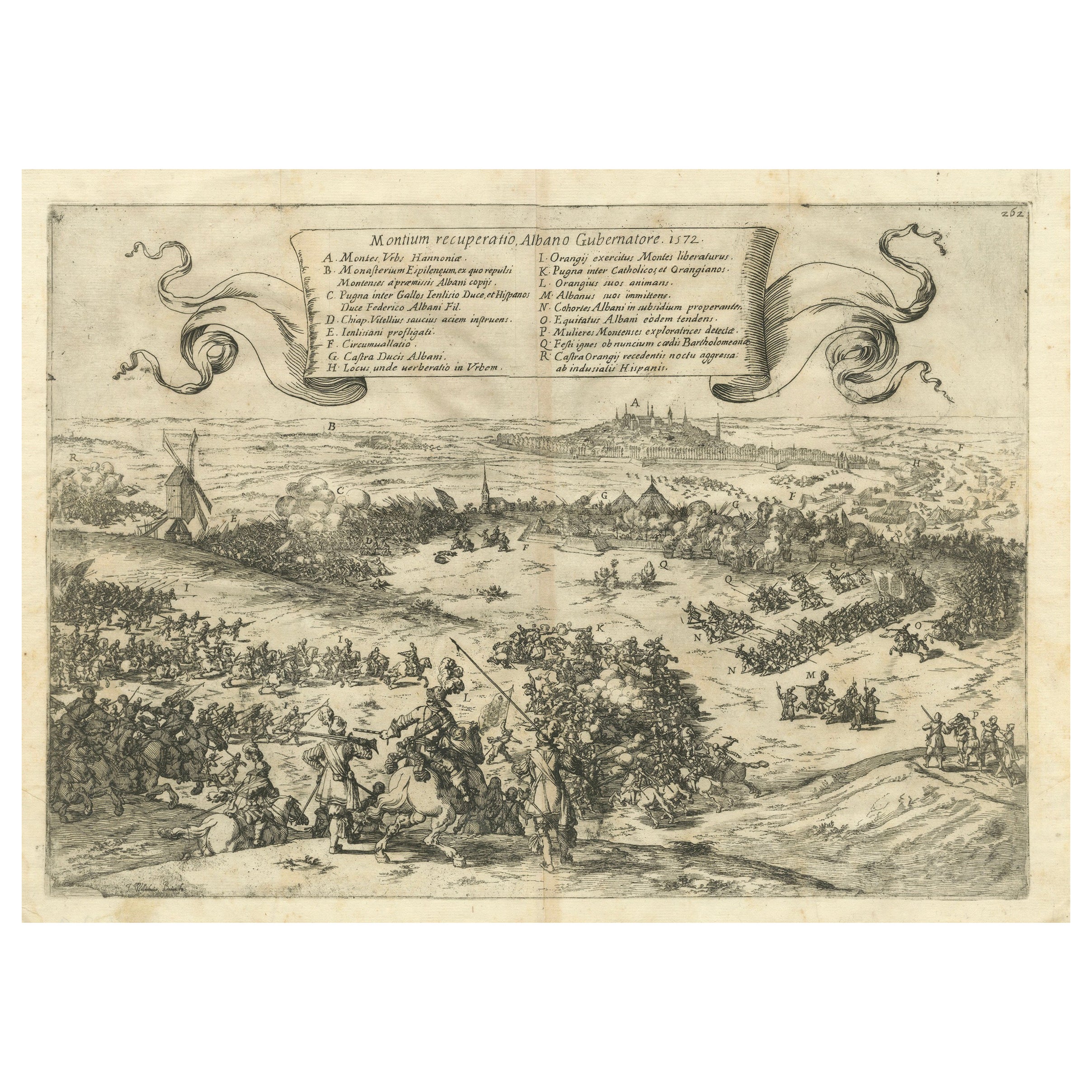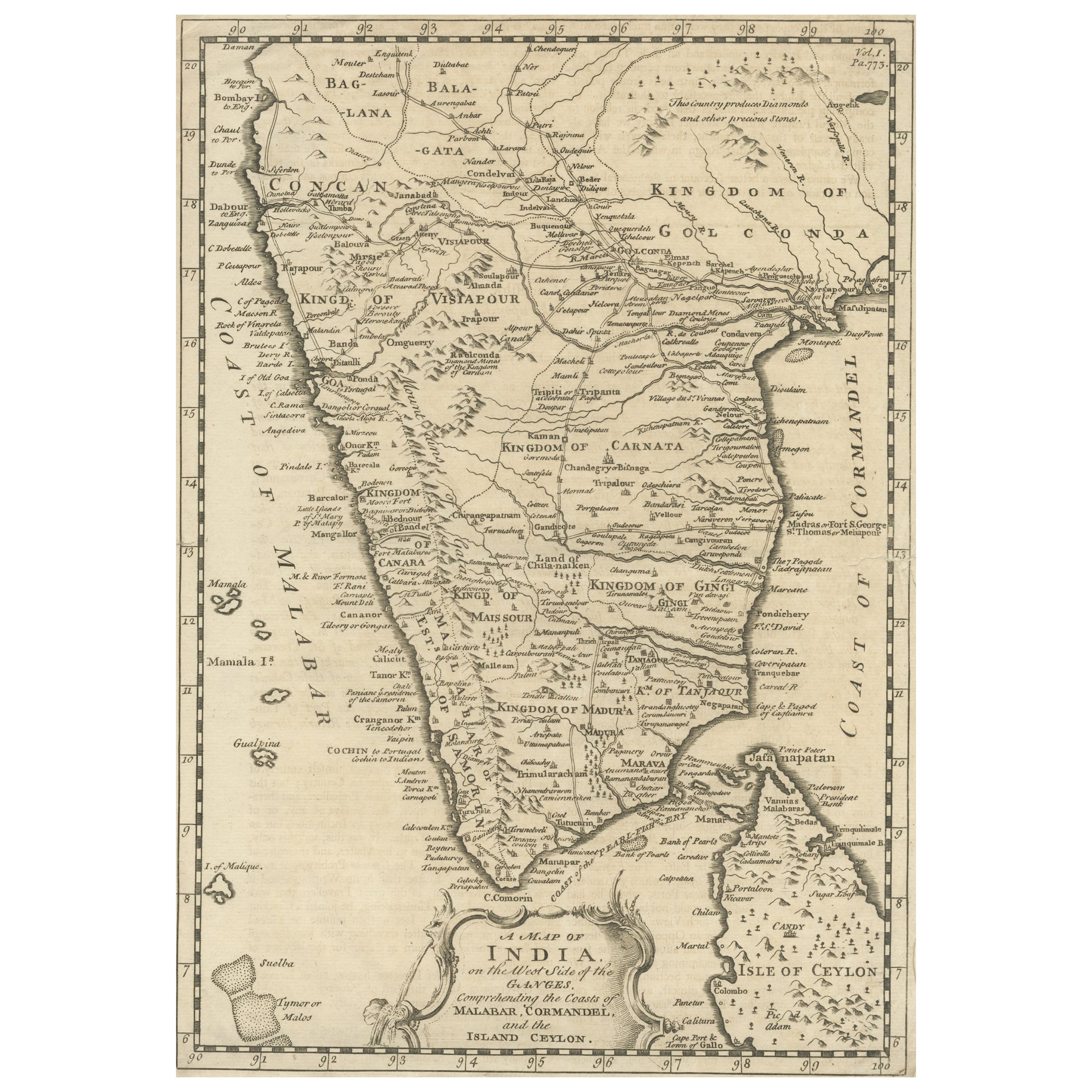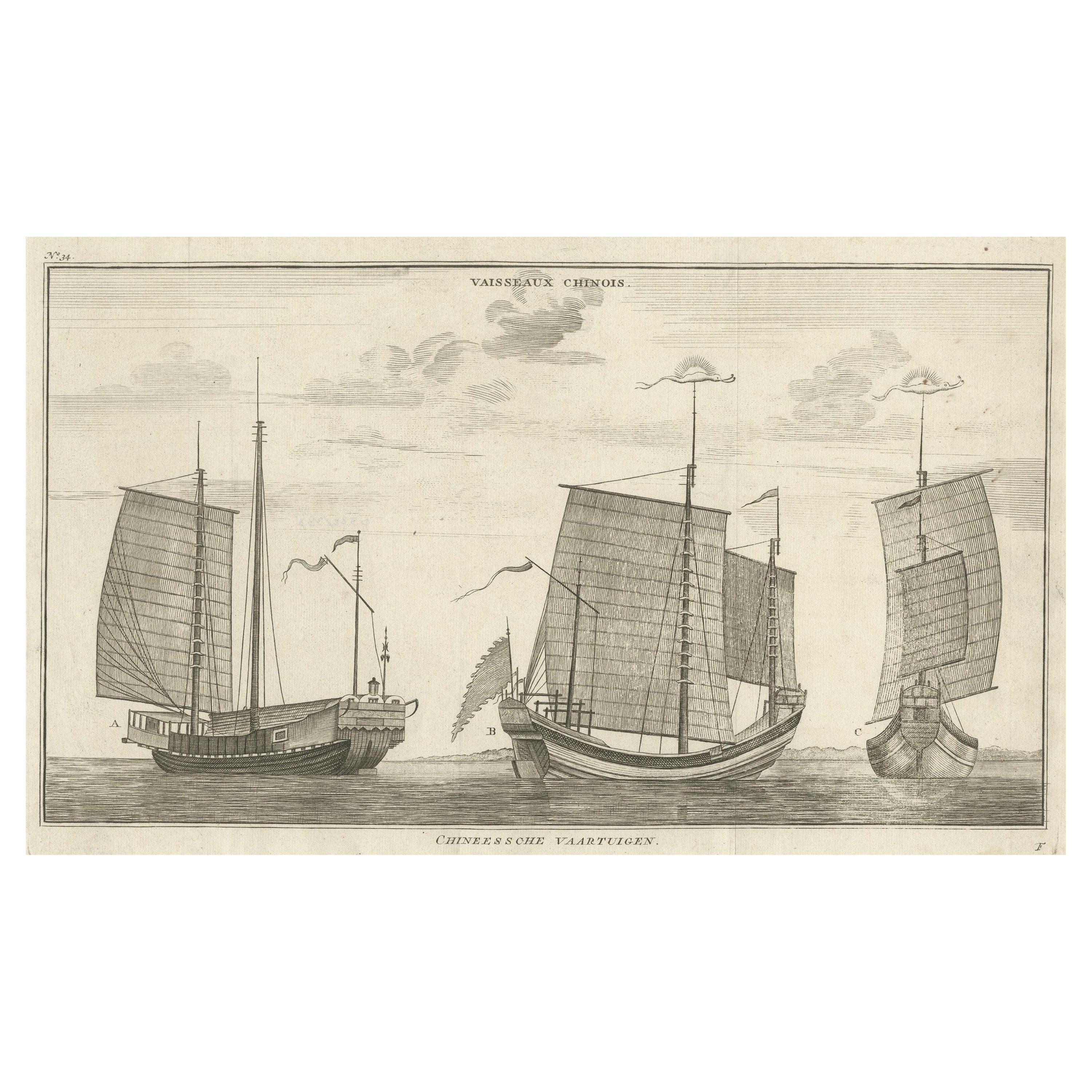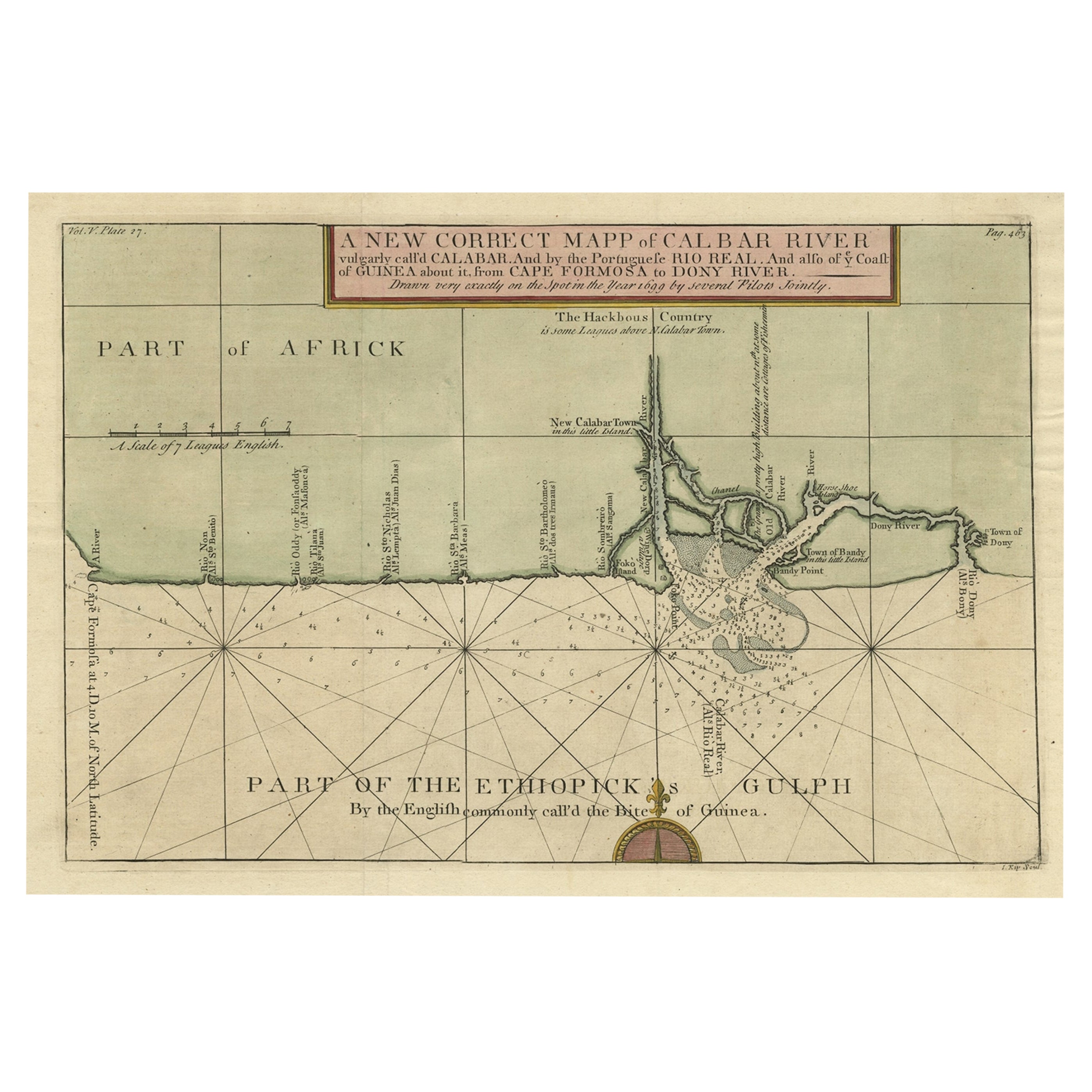Items Similar to Rare Antique Engraving of Life Near The Sestro River, Liberia in Africa, 1744
Want more images or videos?
Request additional images or videos from the seller
1 of 5
Rare Antique Engraving of Life Near The Sestro River, Liberia in Africa, 1744
About the Item
Description: Antique print, titled: 'A map of Sestro River (…).' - This plate shows Fish, birds, animals and people in the area around the Sestro River, Liberia. Inset; a small map of the mouth of the river. From: "A Collection of Voyages and Travels" published by John and Awnsham Churchill in London in 1744.
Artists and Engravers: Made by 'Johannes Kip' after 'A. Churchill'. Johannes Kip (b Amsterdam, 1653; d London, 1722). Dutch draughtsman, engraver and dealer, active in England. He was a pupil of Bastiaen Stopendaal (1636–1707) from 1668 to 1670. His earliest dated engravings are of 1672 (e.g. the Siege of Groningen , Hollstein, no. 4), and he supplied numerous plates for books published from that date onwards. His work brought him into contact with the court of William of Orange and in 1686 he produced six plates depicting William of Orange, his Wife and Attendants near The Hague (Hollstein, no. 5). Shortly after the Glorious Revolution of 1688 Kip followed the court to England. After settling in Westminster, he worked extensively for London publishers, engraving works after Francis Barlow, Caius Gabriel Cibber (e.g. Interior of the Danish Church in London , 1697; Hollstein, no. 6) and other London-based artists. His engravings were principally destined for book illustrations. The work for which Kip is best remembered is his large corpus of topographical engravings of country mansions, which were published first in 1708 as Britannia Illustrata: Or Views of Several of the Queen’s Palaces, as Also of the Principal Seats of the Nobility and Gentry of Great Britain, Curiously Engraven on 80 Copper Plates . This book is among the most important English topographical publications of the 18th century. The subjects were engraved by Kip after ‘bird’s-eye’ drawings executed by Leonard Knyff. The 65 folio plates of The Ancient and Present State of Gloucestershire (1712) by Sir Robert Atkyns (1647–1711), drawn and engraved by Kip, are among the finest collections of topographical illustrations in English publishing. They are also reliable illustrations of the development of the English garden. Kip also dealt in prints from his house in St John’s Street in Westminster. Awnsham Churchill (d. 1728), bookseller, was connected with the family of the Churchills of Colliton, Dorsetshire, and I was the son of William Churchill of Dorchester. He was apprenticed to Cieorge Sawbridge, and he and his brother John entered into business as booksellers and stationers at the sign of the Black Swan in Paternoster Row. They 'were of an universal trade,' says Dunton. 'I traded very considerably with them for several years ; and must do them the justice to say that I was never concerned with any persons more exact in their accompts and more just in their payments' (Life, i. 204). They published in 1695 the edition of Camden's 'Britannia' by Bishop Gibson, who used a manuscript (now lost) of John Aubrey, which he called 'Monumenta Britannica,' lent to him by Churchill, and which was preserved by the Churchill family down to the commencement of the present century. A second edition of Gibson's Camden was issued by Awnsham alone in 1722. Their next most important publication was the well-known work with which their name is usually associated : 'A Collection of Voyages and Travels, some now first printed from original MSS., others translated out of foreign languages and now first published in English ; in four volumes, witn an original preface giving an account of the progress of navigation,' &c., 1704, 4 vols, folio. It was issued to subscribers in that year, and the publishers stated that they possessed materials for two more volumes. These came out in 1732, 'printed by assignment from Messrs. Churchill.' The first four volumes were reissued (new title-pages only) in 1732 ; a ' third edition ' of the six volumes is dated 1744-6; and another by Thomas Osborne, 1752. 'A Collection from the Library of the Earl of Oxford,' London, T. Osborne, 1745 and 1747, 2 vols, folio, known as the 'Harleian Collection,' and a similar collection by John Harris (1744-8, 2 vols, folio), are usually added to Churchill's collection, making up a valuable set of reprints of voyages and travels. It is stated on the title-page of the third edition that the preliminary essay on the history of navigation is 'supposed to be written bv the celebrated Mr. Locke,' and it is includea in the works of the philosopher (1812). The authorship is doubtful, but Locke had much to do with getting together the materials of the collection, which is likely to have been produced at his instigation. Locke was upon friendly terms with Awnsham Churchill for many years, and left him a small legacy.
- Dimensions:Height: 13.67 in (34.7 cm)Width: 16.03 in (40.7 cm)Depth: 0 in (0.02 mm)
- Materials and Techniques:
- Period:1740-1749
- Date of Manufacture:1744
- Condition:Condition: Good, given age. Light vertical crease. Original folds as issued. General age-related toning and/or occasional minor defects from handling. Please study scan carefully.
- Seller Location:Langweer, NL
- Reference Number:Seller: PCT-61659 1stDibs: LU3054326426682
About the Seller
5.0
Platinum Seller
These expertly vetted sellers are 1stDibs' most experienced sellers and are rated highest by our customers.
Established in 2009
1stDibs seller since 2017
1,947 sales on 1stDibs
Typical response time: <1 hour
- ShippingRetrieving quote...Ships From: Langweer, Netherlands
- Return PolicyA return for this item may be initiated within 14 days of delivery.
Auctions on 1stDibs
Our timed auctions are an opportunity to bid on extraordinary design. We do not charge a Buyer's Premium and shipping is facilitated by 1stDibs and/or the seller. Plus, all auction purchases are covered by our comprehensive Buyer Protection. Learn More
More From This SellerView All
- Rare Engraving of Dutch and Danish Forts on the West African Gold Coast, 1744Located in Langweer, NLAntique print, titled: 'The Dutch Fort Croevecoeur (…).' A four panel plate showing forts on the West African Gold Coast, Ghana; a) The Dutch Fort Croevecoeur at Accra, b) The Danish Fort Christiaenburgh at Accra, c) Cape Ruygehoeck or Duyvelsbergh, d) The Prospect of the Village and Coast of Lay, the mount Redonda being at NNE. Ussher Fort is a fort in Accra, Ghana. It was built by the Dutch in 1649 as Fort Crevecoeur. From: "A Collection of Voyages and Travels" published by John and Awnsham Churchill in London in 1744. Artists and Engravers: Made by 'Johannes Kip' after 'A. Churchill'. Johannes Kip (b Amsterdam, 1653; d London, 1722). Dutch draughtsman, engraver and dealer, active in England. He was a pupil of Bastiaen Stopendaal (1636–1707) from 1668 to 1670. His earliest dated engravings are of 1672 (e.g. the Siege of Groningen , Hollstein, no. 4), and he supplied numerous plates for books published from that date onwards. His work brought him into contact with the court of William of Orange and in 1686 he produced six plates depicting William of Orange, his Wife and Attendants near The Hague (Hollstein, no. 5). Shortly after the Glorious Revolution of 1688 Kip followed the court to England. After settling in Westminster, he worked extensively for London publishers, engraving works after Francis Barlow, Caius Gabriel Cibber (e.g. Interior of the Danish Church in London , 1697; Hollstein, no. 6) and other London-based artists. His engravings were principally destined for book illustrations. The work for which Kip is best remembered is his large corpus...Category
Antique 1740s Maps
MaterialsPaper
- Antique Copper Engraving of a Kangaroo in Australia, 1744Located in Langweer, NLThe title 'Quadrupede Nomme Kanguroo, Trouve sur la Cote de la N'le Hollande' refers to an uncolored engraving depicting a Kangaroo, originally found and described during Captain Cook's first voyage, later rendered by George Stubbs in the English account. This French version offers a portrayal of the Kangaroo encountered on the coast of New Holland (Australia) during that expedition. The Kangaroo illustration, an integral part of the narrative from Cook's exploration, became renowned due to its significance in the documentation of newly discovered fauna. George Stubbs, a celebrated artist, interpreted and immortalized this image in the English account of Cook's voyage. This uncolored engraving presents a historical representation of the Kangaroo, an iconic symbol of Australia's unique wildlife, as observed and documented during a pivotal period of exploration. The illustration stands as a testament to the scientific curiosity and documentation prevalent during early voyages of discovery, contributing to the understanding and documentation of the natural world in the 18th century. The print is in good condition, considering its age, but does have a few slightly visible vertical creases and some soiling. Nevertheless a very representable print of a few hunderd years old (1744). Description: This engraving is based on the first illustration of a “Kangaroo” an Australian species, drawn by George Stubbs from a specimen collected at Endeavour River in 1770 by James Cook’s crew while the Endeavour was being careened and issued in the official accounts of the voyage of the Endeavour. This iconic image captured the public’s imagination for over sixty years and was the first depiction of any Australian animal in western art. Confusion exists as to the original species described, based on the specimens brought back by Cook and the subsequent painting by Stubbs. This situation arose in the comparisons of drawings and photographs which are the only records of the lost original specimens, with Parkinson’s sketch made on 23rd June 1770 at Endeavour River and the later Stubbs painting...Category
Antique 1740s Prints
MaterialsPaper
- Engraving of Buginese people near Batavia, East Indies, Indonesia, 1744By Philip BaldaeusLocated in Langweer, NLAntique print, titled: 'A Bougis of Bokjes' - This plate shows Buginese people near Batavia, East Indies, Indonesia. The Buginese people are an ethnic group - the most numerous o...Category
Antique 18th Century Prints
MaterialsPaper
- Antique Engraving of Javanese Man and Woman in Indonesia, 1744Located in Langweer, NLAntique print, titled: 'A Javanese Man and Wooman.' - This plate shows a man and woman from Java, Indonesia. It originally accompanied J. Nieuhof's account of his 'Voyages and Travel...Category
Antique 18th Century Prints
MaterialsPaper
- Copperplate Engraving Showing Forts on the West African Gold Coast, Ghana, 1744Located in Langweer, NLAntique print, titled: 'The Fort Fredricksburg formerly to ye Danes and now Fort Royal (…).' - A three panel copperplate engraving showing three forts on the West African Gold Coast, Ghana; a) The Fort Fredricksburgh formerly to ye Danes and now Fort Royal. English at Manfroe, b) The Fort Amsterdam at Cormentyn belonging to ye Hollanders, c) The Fort James, English at Accra. From: "A Collection of Voyages and Travels" published by John and Awnsham Churchill in London in 1744. Artists and Engravers: Made by 'Johannes Kip' after 'A. Churchill'. Johannes Kip (b Amsterdam, 1653; d London, 1722). Dutch draughtsman, engraver and dealer, active in England. He was a pupil of Bastiaen Stopendaal (1636–1707) from 1668 to 1670. His earliest dated engravings are of 1672 (e.g. the Siege of Groningen , Hollstein, no. 4), and he supplied numerous plates for books published from that date onwards. His work brought him into contact with the court of William of Orange and in 1686 he produced six plates depicting William of Orange, his Wife and Attendants near The Hague (Hollstein, no. 5). Shortly after the Glorious Revolution of 1688 Kip followed the court to England. After settling in Westminster, he worked extensively for London publishers, engraving works after Francis Barlow, Caius Gabriel Cibber (e.g. Interior of the Danish Church in London , 1697; Hollstein, no. 6) and other London-based artists. His engravings were principally destined for book illustrations. The work for which Kip is best remembered is his large corpus...Category
Antique 1740s Prints
MaterialsPaper
- Antique Map of Western and Eastern Barbary in Africa, c.1744Located in Langweer, NLAntique map titled 'A New & Accurate Map of the Western Parts of Barbary' and 'A New & Accurate Map of the Eastern Parts of Barbary'. Decorative maps of North Africa and the Southern...Category
Antique 18th Century Maps
MaterialsPaper
You May Also Like
- "The Battle of Bunker's Hill, Near Boston" Engraving by James Mitan, 1801By John TrumbullLocated in Colorado Springs, COThis dramatic Revolutionary War engraving of the Battle of Bunker Hill is after the famous 1785 oil-on-canvas by John Trumbull. Capturing the intensity of the battle, the engraving centers on Major John Small restraining a “lobster-back” from bayoneting Major General Joseph Warren. Warren lies mortally wounded in the midst of chaos around him. In the background, British forces are seen cresting the last defenses of the brave, yet green army of Colonial soldiers. The Battle of Bunker Hill was fought on June 17, 1775, in the early stages of the American Revolutionary War. The battle is named after Bunker Hill in Charlestown, Massachusetts. Although it was the original objective of both the Colonial and British troops, the area was only peripherally involved in the battle. Rather, the majority of the combat took place on the adjacent Breed’s Hill. The battle pitted a more organized British force against a young and inexperienced American militia. Although considered a tactical victory for the British, it came at the cost of considerable casualties, including a large number of officers. The battle demonstrated that the inexperienced American militia was able to stand up to the British army troops in battle. The battle results discouraged the British from any further frontal attacks against well-defended front lines. American casualties were comparatively fewer, although their losses included Gen. Joseph Warren. During the battle, the patriot-turned-painter John Trumbull (1756-1843) was stationed in Roxbury on the far side of Boston, where he could hear the sounds of fighting. In late 1785, Trumbull decided to devote himself to the depiction of Revolutionary War scenes, a series of eight epic pictures. From the beginning, Trumbull intended for the paintings to be later engraved for sale. Trumbull began the oil-on-canvas of The Death of General Warren at the Battle of Bunker’s Hill and The Death of General Montgomery in the Attack of Quebec, in the studio of Benjamin West in London. Bunker’s Hill was completed in March 1786; Trumbull started Attack of Quebec in February 1785 and finished it before he brought it to Paris in 1786. He then started The Declaration of Independence at Thomas Jefferson's house in Paris. As soon as Bunker’s Hill was completed, Trumbull searched for a suitable engraver in London. He was unsuccessful, as many British engravers were nervous about engraving an American battle...Category
Antique Early 1800s English Federal Prints
MaterialsPaper
- Original Antique Map of Bethune and the Earldom of Artois c. 1744 by J. BasireLocated in Montréal, CABethune. A Strong Town in the Earldom of Artois in the Low Countries, Subject to the French. J. Basire Sculp. Lower Center: Plan of Bethune. For Mr. Tindal's Continuation of Mr. Rapi...Category
Antique Mid-18th Century British Prints
MaterialsPaper
- Antique 1842 English Fullarton African Rhino Rhinoceros Engraving 28"By Oliver Goldsmith (Irish)Located in Dayton, OHAntique 19th century circa 1842 colored engraving of a Rhinoceros - Plate VII from "A History of the Earth and Animated Nature" by Oliver Goldsmith (originally published 1774). From ...Category
Antique 1840s Victorian Prints
MaterialsPaper
- Antique Hand Colored Engraving of the Port of RotterdamLocated in Bradenton, FLAn antique hand colored engraving showing the port of Rotterdam. Inscribed in Latin and Italian “Prospectus portæ veteris roterodamensis / vista de la puerta vieja a roterdam” which translates to ‘View of the old gate...Category
Antique Late 19th Century Prints
MaterialsGlass, Wood, Paper
- Antique Engraving Print "The Order Of The Bath" Burton Barber, 1920sLocated in London, GBThis beautiful antique colored engraving is titled "THE ORDER OF THE BATH" by the original artist C. Burton Barber and beautifully, circa 19...Category
Vintage 1920s Prints
MaterialsOther
- Engraving Devonport, Dockyard, and the River Tamar, From Mount Edgcumbe C 1829Located in Atlanta, GAEnglish Engraving Devonport, Dockyard, and the River Tamar, From Mount Edgcumbe Circa 1829 Title: Devonport, Dock-Yard, and the River Tamar, from Mount Edgcumbe. Artist: Thomas Al...Category
Antique Early 19th Century Prints
MaterialsGiltwood, Paper
Recently Viewed
View AllMore Ways To Browse
Engravings Set Of 6
Antique Apprentice Furniture
Antique Apprentice
Brother Antique Black
Antique Two Tone Light
Bird Wall Light
Antique Oxford
Set Of Antique Plates London
Row Of Seats
Wall Plates Set Of 4
18th C New England
E African
African Queen
Antique Folding Seat
Antique Foldable Seat
Large Corpus
Siege Antique
Swan Down





